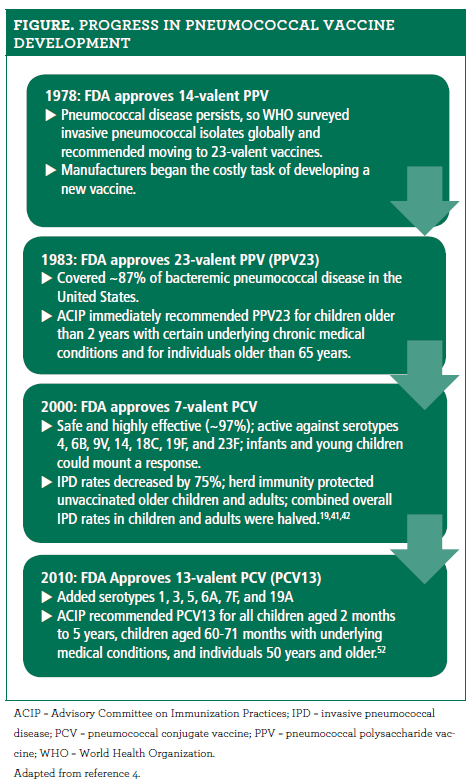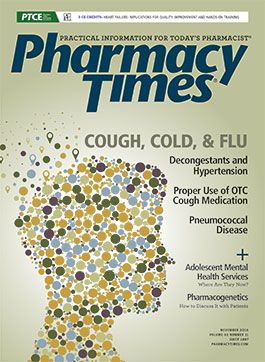Publication
Article
Pharmacy Times
Pneumococcal Disease: Changing Under the Pressure of Vaccination
Author(s):
To completely understand pneumococcal vaccines and appreciate the progress in this area, pharmacists need to review some history.
Streptococcus pneumoniae infection is a leading cause of morbidity globally. Researchers have identified more than 90 S pneumoniae serotypes based on the organism’s polysaccharide capsule. As many as 40% to 60% of young children are colonized with S pneumoniae.1 The severe form of the infection, invasive pneumococcal disease (IPD), causes severe blood or cerebrospinal illnesses (and often death).2 Before effective vaccines were available, this organism caused approximately 11% of deaths in children younger than 5 years.3
To completely understand pneumococcal vaccines and appreciate the progress in this area, pharmacists need to review some history (Figure4). During World Wars I and II, countless soldiers died of complications, mainly pneumococcal pneumonia, during pandemic flu epidemics. Until the 1970s, high development costs and low societal acceptance were barriers to vaccine development. As antibiotic resistance grew and statisticians documented pneumococcal infections’ huge human and financial costs, interest in a vaccine increased. The FDA approved a 14-valent pneumococcal polysaccharide vaccine (PPV) in 1978.4

Early Modern Vaccines
The World Health Organization (WHO), concerned that the 1978 vaccine was insufficient to prevent most pneumococcal disease, continued surveying invasive pneumococcal isolates globally to identify serotypes of greatest concern. Subsequently, WHO recommended moving to 23-valent vaccines, and by 1983, this was a reality.5,6
Children younger than 2 years could not mount an adequate response to PPV23 because nonconjugated PPVs activate B cells, but elicit T-cell-independent immune responses. Children lack the mature immune system needed to complete this task. However, children older than 2 years responded at rates of 57% to 75%.5,6 PPVs have limitations: they do not induce immune memory, have no booster effect, and have almost no effect on nasopharyngeal carriage in patients of any age.7
A safe vaccine for children became a reality in 2000 when the FDA licensed a pneumococcal conjugate vaccine (PCV7). PCV7 was moderately effective against pneumonia and somewhat effective at reducing otitis media episodes.8-10 The Advisory Committee on Immunization Practices (ACIP) immediately recommended routine PCV7 use in children aged 2 to 23 months and in children aged 24 to 59 months with anatomic or functional asplenia, sickle cell disease (SCD), any immunocompromising condition, or chronic illness.11 In 2007, the ACIP expanded its recommendation to include all children aged 2 to 59 months.12
Within a year, IPD caused by PCV7-covered serotypes had been completely eliminated in US children younger than 5 years, an accomplishment akin to a modern miracle. Over several years, the vaccine reduced preventable infection by 94% in all ages.3
Although PCV7’s impact was robust, diseases caused by serotypes not included in PCV7 (ie, serotypes 6A [which is partially covered in PCV7], 15, and 19A) increased in children and certain adult populations. Called “replacement disease,” increases in infection were small, but concerning, compared with the overall disease reduction.13,14 Serotype 19A was a special concern because of multidrug resistance.15-19
In February 2010, the FDA approved PCV13, which replaced PCV7. PCV13 is approved for the prevention of IPD among infants and young children. With PCV13’s 6 additional serotypes, health scientists hoped that its introduction would reduce the number of IPD cases.20
The PPV23 vaccine remains a safe, important intervention. Serotypes covered in PPV23, but not newer vaccines, still result in a high burden of IPD, and broader protection is needed in patients who are immunocompromised or at elevated risk.
Pneumococcal Persistence
Despite the availability of vaccines, IPD and influenza are the 8th leading cause of death in the United States.21 How could this be? The problem is serotype replacement and nonvaccine serotypes.
Serotype replacement can occur through (1) increased prevalence of serotypes already present in the population or (2) appearance and spread of new serotypes that had been unable to cause disease until the vaccine eliminated more pathogenic serotypes; in other words, the serotypes emerge when competition is eliminated.22
The mechanism of serotype replacement is unclear. It is probably a multifaceted phenomenon that involves new serotypes, similar serotypes that co-transform (eg, 19F into 19A, conferring penicillin resistance), or a bacterial capsular switch.23 Antibiotic use, environmental conditions, geographic location, frequency of comorbid conditions, immunosuppression, or other factors also cause noteworthy increases in non-PCV7 serotypes in some populations.23
Current vaccines are unable to eliminate nasopharyngeal carriage, providing a reservoir for some serotypes to remain in circulation. Eventually, killed whole-cell pneumococcal vaccines may be able to induce an immune response and eliminate nasopharyngeal carriage.24,25
Serotype replacement, while a concern, does not outweigh the benefits of vaccination.26
The Pharmacist’s Role
Pneumococcal vaccination rates among children are high, but rates among adults—targeted at 90% for individuals 65 years and older and those with high-risk conditions—are around 30% to 50%.27,28 The Table29 lists CDC recommendations for specific pneumococcal vaccines.
Table. Current CDC Recommendations for Pneumococcal Vaccine
Vaccine
Immunization Indications
PCV-13
- Children 6 weeks through 17 years of age (prior to 18th birthday) for the prevention of invasive disease caused by its 13 serotypes
- Children 6 weeks through 5 years of age (prior to sixth birthday) for the prevention of otitis media caused by serotypes 4, 6B, 9V, 14, 18C, 19F, and 23F
- Adults 50 years and older for the prevention of pneumonia and invasive disease caused by Streptococcus pneumoniae serotypes 1, 3, 4, 5, 6A, 6B, 7F, 9V, 14, 18C, 19A, 19F, and 23F.
PPV-23
Children 2 years and older and individuals 50 years and older who are at increased risk for pneumococcal disease caused by the 23 serotypes included in the vaccine, including individuals with the following:
- Functional or anatomic asplenia, including sickle cell disease or other hemoglobinopathies, congenital or acquired asplenia, splenic dysfunction, or splenectomy
- Immunocompetent children and adolescents with chronic heart disease, chronic lung disease (including asthma if treated with high-dose corticosteroids), diabetes, cerebrospinal fluid leaking, or cochlear implants
- Immunocompetent adults 19-64 years of age with chronic heart disease, chronic lung disease, diabetes, cerebrospinal fluid leaking, cochlear implants, alcoholism, chronic liver disease, or cirrhosis, or who smoke cigarettes
- Congenital or acquired immunodeficiency, HIV infection, chronic renal failure, nephrotic syndrome, leukemia, lymphoma, Hodgkin disease, generalized malignancies, solid organ transplant, multiple myeloma, or other diseases requiring immunosuppression
- All adults 65 years and older
PCV-13 and PPV-23
recent change
- Interval for PCV-13 followed by PPV-23 changed from “6-12 months” to “at least 1 year” for immunocompetent adults 65 years and older who do not have immunocompromising conditions, anatomic or functional asplenia, cerebrospinal fluid leaking, or cochlear implants; the interval for adults 19 years and older with any of these conditions is at least 8 weeks
PCV = pneumococcal conjugate vaccine; PPV = pneumococcal polysaccharide vaccine.Adapted from reference 29.
Older patients skip the vaccination for several reasons. Anti-vaccine sentiments, devaluation of preventive care late in life, skepticism about effectiveness, and cost can decrease immunization rates.23,24 Pharmacists need to remind older patients that they can contract vaccine-preventable illnesses. Medicare covers this vaccination.
Influenza/Pneumococcus coinfection is common during epidemics and causes up to 25% of all influenza-related deaths.30 Seniors vaccinated against influenza and pneumococcal disease reduce their risk of all-cause pneumonia by 29% and mortality by 35%.26,31-33 The message we need to deliver is simple: seniors need pneumococcal and influenza vaccinations.
Ms. Wick is a visiting professor at the University of Connecticut School of Pharmacy, where she teaches immunization technique.
References
- Streptococcus pneumonia. CDC website. cdc.gov/pneumococcal/clinicians/streptococcus-pneumoniae.html. Accessed August 15, 2016.
- Pneumococcal disease. CDC website. cdc.gov/vaccines/pubs/pinkbook/pneumo.html. Accessed August 16, 2016.
- O’Brien KL, Wolfson LJ, Watt JP, et al; Hib and Pneumococcal Global Burden of Disease Study Team. Burden of disease caused by Streptococcus pneumoniae in children younger than 5 years: global estimates. Lancet. 2009;374(9693):893-902. doi: 10.1016/S0140-6736(09)61204-6.
- Grabenstein JD, Klugman KP. A century of pneumococcal vaccination research in humans. Clin Microbiol Infect. 2012;18(suppl 5):S15-S24. doi: 10.1111/j.1469-0691.2012.03943.x.
- Prevention of pneumococcal disease: recommendations of the Advisory Committee on Immunization Practices (ACIP). MMWR Recomm Rep. 1997;46(RR-8):1-24.
- Updated recommendations for prevention of invasive pneumococcal disease among adults using the 23-valent pneumococcal polysaccharide vaccine (PPSV23). Centers for Disease Control and Prevention (CDC); Advisory Committee on Immunization Practices. MMWR. 2010;59(34):1102-1106.
- Pitsiou GG, Kioumis IP. Pneumococcal vaccination in adults: does it really work? Respir Med. 2011;105(12):1776-1783. doi: 10.1016/j.rmed.2011.07.008.
- Black S, Shinefield H, Fireman B, et al. Efficacy, safety and immunogenicity of heptavalent pneumococcal conjugate vaccine in children. Northern California Kaiser Permanente Vaccine Study Center Group. Pediatr Infect Dis J. 2000;19(3):187-195.
- Black SB, Shinefield HR, Ling S, et al. Effectiveness of heptavalent pneumococcal conjugate vaccine in children younger than five years of age for prevention of pneumonia. Pediatr Infect Dis J. 2002;21(9):810-815.
- Eskola J, Kilpi T, Palmu A, et al; Finnish Otitis Media Study Group. Efficacy of a pneumococcal conjugate vaccine against acute otitis media. N Engl J Med. 2001;344(6):403-409.
- Advisory Committee on Immunization Practices. Preventing pneumococcal disease among infants and young children: recommendations of the Advisory Committee on Immunization Practices (ACIP). MMWR Recomm Rep. 2000;49(RR-9):1-35.
- Centers for Disease Control and Prevention (CDC); Advisory Committee on Immunization Practices (ACIP). Updated recommendation from the Advisory Committee on Immunization Practices (ACIP) for use of 7-valent pneumococcal conjugate vaccine (PCV7) in children aged 24-59 months who are not completely vaccinated. MMWR Morb Mortal Wkly Rep. 2008;57(13):343-344.
- Centers for Disease Control and Prevention (CDC). Direct and indirect effects of routine vaccination of children with 7-valent pneumococcal conjugate vaccine on incidence of invasive pneumococcal disease—United States, 1998-2003. MMWR Morb Mortal Wkly Rep. 2005;54(36):893-897.
- Flannery B, Heffernan RT, Harrison LH, et al. Changes in invasive pneumococcal disease among HIV-infected adults living in the era of childhood pneumococcal immunization. Ann Intern Med. 2006;144(1):1-9.
- Byington CL, Hulten KG, Ampofo K, et al. Molecular epidemiology of pediatric pneumococcal empyema from 2001 to 2007 in Utah. J Clin Microbiol. 2010;48(2):520-525. doi: 10.1128/JCM.01200-09.
- O'Dempsey TJ, McArdle TF, Lloyd-Evans N, et al. Pneumococcal disease among children in a rural area of west Africa. Pediatr Infect Dis J. 1996;15(5):431-437.
- Muñoz-Almagro C, Jordan I, Gene A, Latorre C, Garcia-Garcia JJ, Pallares R. Emergence of invasive pneumococcal disease caused by nonvaccine serotypes in the era of 7-valent conjugate vaccine. Clin Infect Dis. 2008;46(2):174-182. doi: 10.1086/524660.
- Whitney CG, Farley MM, Hadler J, et al; Active Bacterial Core Surveillance of the Emerging Infections Program Network. Decline in invasive pneumococcal disease after the introduction of protein-polysaccharide conjugate vaccine. N Engl J Med. 2003;348(18):1737-1746.
- Aaberge IS. Experience with pneumococcal conjugate vaccine in Norway. Expert Rev Vaccines. 2009;8(2):159-165. doi: 10.1586/14760584.8.2.159.
- Centers for Disease Control and Prevention (CDC). Licensure of a 13-valent pneumococcal conjugate vaccine (PCV13) and recommendations for use among children - Advisory Committee on Immunization Practices (ACIP), 2010. MMWR Morb Mortal Wkly Rep. 2010;59(9):258-261.
- Heron M, Tejada-Vera B. Deaths: leading causes for 2005. Natl Vital Stat Rep. 2009;58(8):1-97.
- Lipsitch M. Bacterial vaccines and serotype replacement: lessons from Haemophilus influenzae and prospects for Streptococcus pneumoniae. Emerg Infect Dis. 1999;5(3):336-345.
- Pilishvili T, Lexau C, Farley MM, et al; Active Bacterial Core Surveillance/Emerging Infections Program Network. Sustained reductions in invasive pneumococcal disease in the era of conjugate vaccine. J Infec Dis. 2010;201(1):32-41. doi: 10.1086/648593.
- Assaad U, El-Masri I, Porhomayon J, El-Solh AA. Pneumonia immunization in older adults: review of vaccine effectiveness and strategies. Clin Interv Aging. 2012;(7):453-461. doi: 10.2147/CIA.S29675.
- Lu YJ, Leite L, Goncalves VM, et al. GMP-grade pneumococcal whole-cell vaccine injected subcutaneously protects mice from nasopharyngeal colonization and fatal aspiration-sepsis. Vaccine. 2010;28(47):7468-7475. doi: 10.1016/j.vaccine.2010.09.031.
- Hanage WP, Finkelstein JA, Huang SS, et al. Evidence that pneumococcal serotype replacement in Massachusetts following conjugate vaccination is now complete. Epidemics. 2010;2(2):80-84. doi: 10.1016/j.epidem.2010.03.005.
- Chang YC, Chou YJ, Liu JY, Yeh TF, Huang N. Additive benefits of pneumococcal and influenza vaccines among elderly persons aged 75 years or older in Taiwan—a representative population-based comparative study. J Infect. 2012;65(3):231-238. doi: 10.1016/j.jinf.2012.04.014.
- Healthy people 2020: national health promotion and disease prevention objectives. US Department of Health and Human Services, Public Health Service website. healthypeople.gov. Accessed December 14, 2012.
- ACIP Committee on Immunization Practices: Recommendations — pneumococcal. Immunization Action Coalition website. immunize.org/acip/acipvax_pneum.asp. Accessed August 16, 2016.
- Dear K, Holden J, Andrews R, Tatham D. Vaccines for preventing pneumococcal infection in adults. Cochrane Database Syst Rev. 2003;(4):CD000422.
- Jefferson T, Rivetti D, Rivetti A, Rudin M, Di Pietrantonj C, Demicheli V. Efficacy and effectiveness of influenza vaccines in elderly people: a systematic review. Lancet. 2005;366(9492):1165-1174.
- Christenson B, Hedlund J, Lundbergh P, Ortqvist A. Additive preventive effect of influenza and pneumococcal vaccines in elderly persons. Eur Respir J. 2004;23(3):363-368.
- Weaver M, Krieger J, Castorina J, Walls M, Ciske S. Cost-effectiveness of combined outreach for the pneumococcal and influenza vaccines. Arch Intern Med. 2001;161(1):111-120

Newsletter
Stay informed on drug updates, treatment guidelines, and pharmacy practice trends—subscribe to Pharmacy Times for weekly clinical insights.






